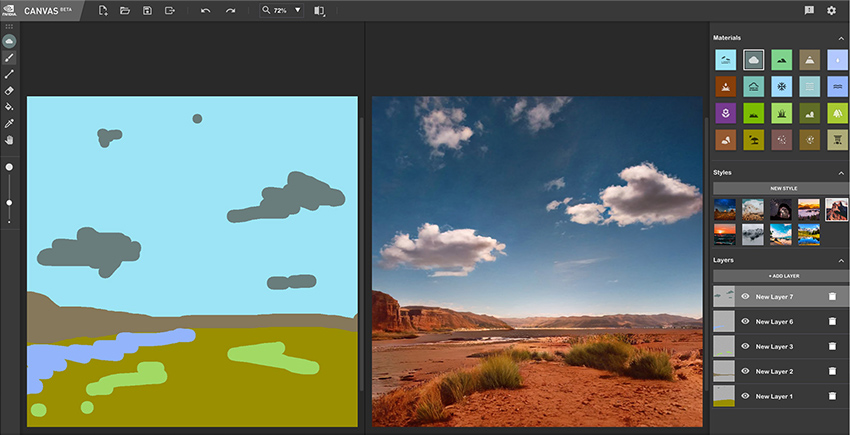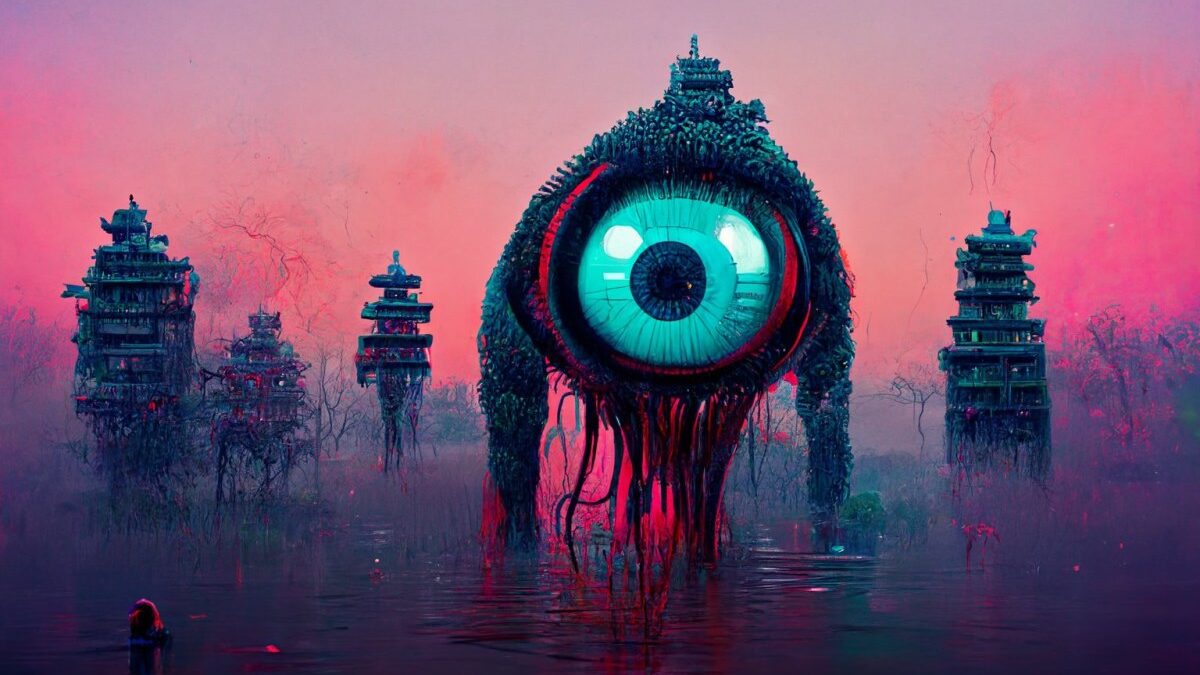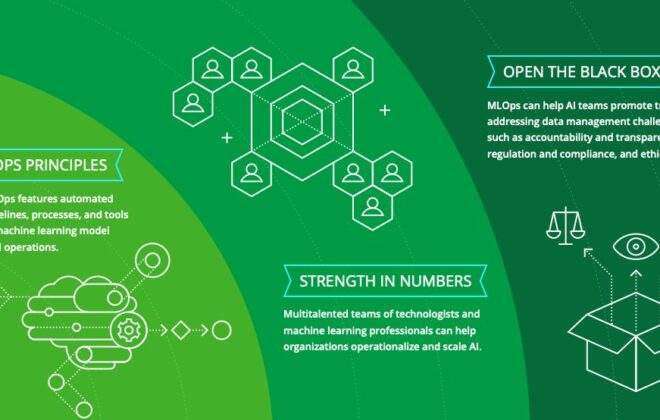Top 6+ GAN Books – Generative Adversarial Networks And Generative AI
If you are familiar with AI in 2022, GANs (Generative Adversarial Networks) should sound very familiar to you. It is a new direction of modern AI. In this article we collected some important GAN applications and useful GAN books for both beginners and advanced programmers.
The GAN technology already showed some incredible applications like Dall E 2, Midjourney, StyleGAN2 or NVIDIA's GauGAN. People are often surprised by the results of a GAN-generated image. This is because the first time you see one, it can look weird and unfamiliar. However, if you take the time to look more closely, you'll see that there is a lot of detail in these images that wouldn't be possible to make with traditional human creativity.
Why GANs are groundbreaking?
Simply because they are capable generating unique, detailed visual content. Unlike ML (Machine Learning) models, which are capable to classify or analyze images, GANs are here to show something new, based on a trained model. See the following showcased pictures generated with Midjourney.

We played a lot with ML models you can check our working AI Cover Reviewer, which is capable to classify the uploaded fiction covers to High or Low quality. We know this is a relative metric, but was a great playground to learn about Tensorflow.js, Lobe.ai and have some experience with training datasets. Anyway it is a fun to try this out.
But GANs are something else, they produce visual value to people.
What Are Generative Adversarial Networks?
A GANs is a generative-modeling approach that uses deep learning algorithms, such as convolutional neural networks.
Using unsupervised pattern recognition in the machine learning field, generative modeling aids the machine automatically discover and repeat patterns in its own data.
GANs are essentially a new field, known for their ability to simulate realistic images in image-transferring processes. Nevertheless, GANs are most commonly utilized in photo-to-photo tasks, such as translating summer to winter or daytime to nighttime pictures, as well as for generating photorealistic pictures that humans can't distinguish from the real thing.

Most Popular GAN Applications
The first GAN demos were art projects. They created art works based on a dataset. Since we know GANs may utilize GPUs' processing ability they are capable to make photo realistic output. That means overall that GAN models could be great for “concept to real life” approach.

3D designers spend hours to create simple 3D environments with high quality textures. With GANs we could simplify their work just by letting them draw simple concepts which could be turned into complex environment.
The same approach could be used for photo backgrounds or similar non-focused content generation.
If you want to play with GANs try NVIDIA Canvas (for NVIDIA RTX cart owners).
Most important GAN applications:
- AI art generation (Midjourney, 2022)
- Image generation based on prompt Dall·E 2 (OpenAI, 2022)
- Image generated based on prompt · open source model (Stable Diffusion, 2022)
- Face photo generation (StyleGAN2, 2019)
- Background, nature background generation (NVIDIA Canvas)
- Interior photo generation (DCGAN, Alec Radford, et al. 2015)
- Cartoon character generation (Yanghua Jin, et al. 2017)
- Creature generation (Chimera painter, 2020)
- Merging certain aspects of images and fuse them (CycleGAN, Jun-Yan Zhu 2017)
- 70's Sci-fi Art (Jeff Heaton, 2020)
What are the best GAN books to read?

Machine Learning with PyTorch and Scikit-Learn, by Sebastian Raschka, Yuxi (Hayden) Liu and Vahid Mirjalili
This book of the latest edition of the widely renowned PyTorch machine-learning series is a detailed explanation of how to utilize machine and deep learning algorithms for easy programming and understandable implementation.
PyTorch and its library Scikit-Learn are an extensive introduction to machine learning and deep learning. It acts as a tutorial and a reference that you can use to become an expert in this area. Why PyTorch? PyTorch is the natural programming language for machine learning, making it easier to learn and to code with. This book explains the essential parts of PyTorch and how to put together models using libraries, including PyTorch Lightning and PyTorch Geometric.
Among GAN books this is one of the latest title this year.

Hands-On Generative Adversarial Networks with PyTorch 1.x, by John Hany and Greg Walters
Generative Adversarial Networks (GANs) are the best way to make use of the latest advances in deep learning technology. The straightforward nature of this book makes it an ideal resource for beginners to make the best use of GANs.
This book will enable you to familiarize yourself with the fundamental concepts that you need to understand in order to construct an GAN model. Setting out your first GAN model will let you gain an understanding of generator and discriminator networks.
By the end of this book, you will know how to organize, train, and optimize GAN models and use them to solve a variety of real life problems.

Generative Deep Learning, by David Foster
With the help of author David Foster, we'll explain the fundamental concepts of deep learning before moving on to the most advanced algorithms in the field. Next, complete with illustrative tips and advice, we will explain how to make neural network models operate more efficiently.
This book mainly focuses generative modeling with deep learning, permitting variationally autoencoders to be discussed. It provides a brief overview of several GAN models, also talks about LSTM (Long short-term memory) models.

GANs in Action, by Jakub Langr and Vladimir Bok
GANs in Action guides you through building and training your own Generative Adversarial Networks. You'll start by building simple generator and discriminator networks, which are the foundation of GAN architecture. From there, after numerous examples, you will focus on training GANs to generate high-resolution images, image-to-image translation, and targeted data generation. Throughout the process, you will learn how to grow a network to correctly and quickly reproduce your original goals.
Inside the book you will find how to build your first Generative Adversarial Network, how to deal with progressive growing of your GANs, applying GANs practically and troubleshooting your system.

Generative AI with Python and TensorFlow 2, by Joseph Babcock and Raghav Bali
This GAN book for Python programmers who want to develop and have some fun using generative models. To help you get the most out of this book, you should be prepared to have basic knowledge of from math and statistics for machine learning.
You will delve into generative models in this book, beginning with the restricted Boltzmann machines and progressing to deep belief networks to VAEs, and ultimately reaching GANs. In addition, you will practice how to implement those concepts yourself using TensorFlow, and read about the cutting-edge research in deep neural networks.
The code examples in the book are in TensorFlow 2, which make it easy for PyTorch users to follow along. Look inside the most famous deep generative models, from GPT to MuseGAN. Learn to build and adapt your own models in TensorFlow 2.x. Explore exciting, cutting-edge use cases for deep generative AI.
This book shows the general knowledge and skills needed to pursue a career in the field, how to build your specific system, and the foundations of the field. It continues with coverage of a wide range of applications.

Make Your First GAN With PyTorch, by Tariq Rashid
This beginner-friendly guide will provide you with hands-on experience: learning PyTorch basics, developing your first PyTorch neural network, exploring neural network enhancement, introducing CUDA GPU acceleration.
This is probably the best possible book I have read on the subject of ML, PyTorch and GANs for beginners. The author shows exceptional skills devised a flow of invaluable insights and any type of technical concepts, making it simple for readers to grasp them. Tariq uses Google Colab, which enables you to develop and execute GAN scripts freely from your laptop.

Generative Adversarial Networks for Image Generation, by Xudong Mao, Qing Li
GAN image generation has demonstrated its success in image generation, but biology has presented a challenging obstacle, and the quality of the generated image and the training stability are the two ultimate challenges.
This book first gives an overview of GANs, followed by information about GAN image generation and its challenges. It also looks at solutions to these challenges.
This book introduces three market-ready applications of GANs, including image translation, unsupervised domain adaptation and image forensics and security. It is directed at academics who are researching GANs, image generation and general machine learning and computer vision.
Ethical aspects of using AI Generated Images
Designers trying out artificial intelligence to create images is something very new, and the ethical aspects of using such an images are mainly unanswered.
We are speaking here about semi-new images. For generating one new image the system uses a GAN (model) created from billions of pictures and art as input. In simple terms generated AI images are a mixture of already existing ones.
GAN galleries like Lexica.art feels like a new shutterstock, where the uniqueness comes from the prompt (the keywords entered to generate the AI image).
Ethical and non-ethical use cases
In certain non-commercial cases we could imagine that using AI images will be ethical and a daily practice
- Illustrating fictional story parts
- Limited usage of certain AI art elements where the element isn't available in stock galleries (because of it's fictional nature)
But there are cases where we think it's completely unethical using AI images
- Illustrating a real-life events (war, accident) with GAN image in an article
- Putting a real-life person in a fictional situation (similar as deep fake videos) or altering real-life person's attributes for the bad (muscle tone) which may impact the reputation of the person negatively
- Selling AI art generated solely by GAN under a real person name
There was a recent story where an AI generated art won Colorado State Fair fine art competition's digital art category.
Final Thoughts on the best GAN books
When looking at the future of AI, it is important to look at all of these different types of GAN applications and not just one in particular. It is also important to note that GANs are a new direction of modern AI and they will be an exciting area for research with promising groundbreaking applications in natural language processing and image generation.
We hope our collection of GAN books will help to learn more how to use GANs in practice. If you are looking for more resources in the filed of artificial intelligence, check our selection of AI books.
The cover have been generated with Midjourney
My profession is online marketing and development (10+ years experience), check my latest mobile app called Upcoming or my Chrome extensions for ChatGPT. But my real passion is reading books both fiction and non-fiction. I have several favorite authors like James Redfield or Daniel Keyes. If I read a book I always want to find the best part of it, every book has its unique value.







